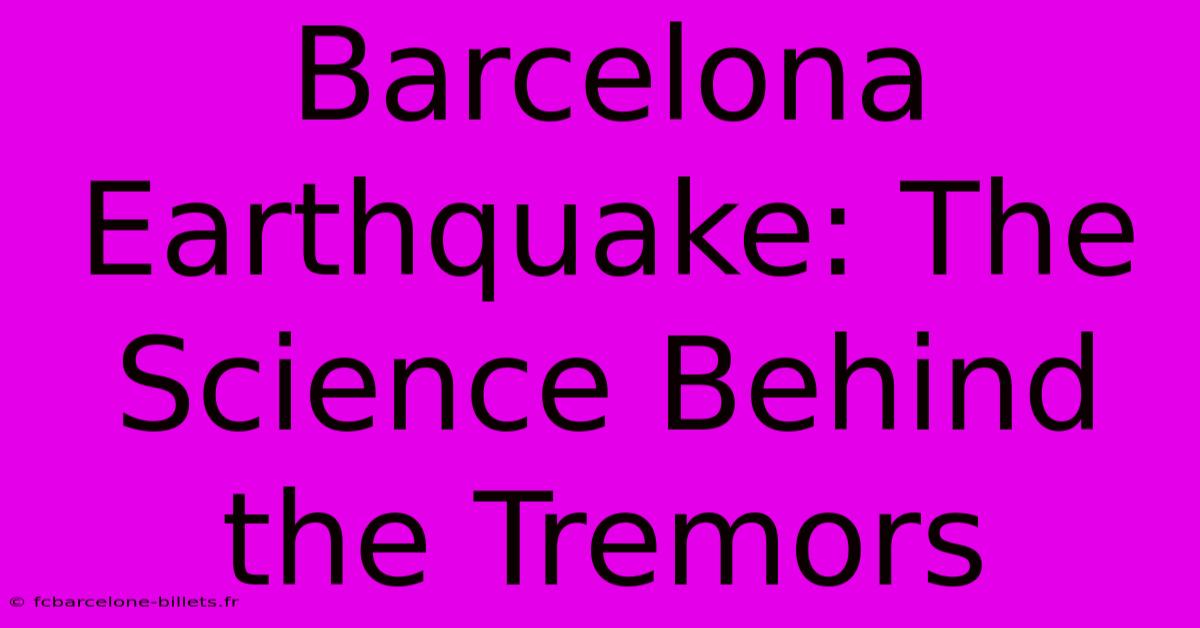Barcelona Earthquake: The Science Behind The Tremors

Table of Contents
Barcelona Earthquake: The Science Behind the Tremors
Barcelona, a city renowned for its vibrant culture and stunning architecture, is not typically associated with earthquakes. However, the Iberian Peninsula sits on a geologically active region, making seismic activity, though infrequent, a possibility. Understanding the science behind these tremors is crucial for preparedness and mitigation. This article delves into the tectonic plates, fault lines, and seismic waves responsible for any earthquake that might affect Barcelona.
Understanding Plate Tectonics: The Root Cause
The Earth's crust is fractured into several massive tectonic plates that are constantly moving, albeit slowly. Plate tectonics is the theory explaining this movement, and it's the fundamental reason behind earthquakes. Barcelona's location on the Eurasian Plate places it near the boundary with the African Plate. These plates are not static; their interaction, often involving immense pressure and friction, leads to the build-up of stress.
The Iberian Microplate: A Complex Interaction
The situation is further complicated by the Iberian Microplate, a smaller tectonic plate situated between the Eurasian and African Plates. This microplate's movement is influenced by the larger plates, creating a complex interplay of forces. The stress accumulated along the plate boundaries can eventually exceed the strength of the rocks, resulting in a sudden release of energy—an earthquake.
Fault Lines: Where the Earth Cracks
Fault lines are fractures in the Earth's crust where these tectonic plates meet. They represent zones of weakness where movement is most likely to occur. While major fault lines are readily identifiable, smaller, less-obvious faults can also be significant sources of seismic activity, especially in the case of smaller tremors. The specific fault lines impacting Barcelona's seismic risk require ongoing geological research and monitoring.
Seismic Waves: The Energy Release
When a fault ruptures, the accumulated energy is released in the form of seismic waves. These waves travel through the Earth, causing the ground to shake. There are several types of seismic waves:
- P-waves (primary waves): These are compressional waves, meaning they travel through the Earth by compressing and expanding the rock. They are the fastest waves and are the first to be detected by seismographs.
- S-waves (secondary waves): These are shear waves that travel by moving the rock particles perpendicular to the direction of wave propagation. They are slower than P-waves and cause more ground shaking.
- Surface waves: These waves travel along the Earth's surface and are responsible for the most significant damage during an earthquake. They are slower than P and S waves but have a larger amplitude.
Predicting Earthquakes: The Ongoing Challenge
Predicting earthquakes with pinpoint accuracy remains a significant scientific challenge. While scientists cannot predict the exact time and magnitude of future earthquakes in Barcelona, they can assess the region's seismic hazard by studying historical records, geological data, and using sophisticated monitoring techniques. This information informs building codes and emergency preparedness plans.
Seismic Monitoring and Early Warning Systems
Modern technology plays a vital role in earthquake monitoring. Seismographs constantly record ground motion, providing valuable data for analyzing seismic activity. Early warning systems use this data to issue alerts before the most damaging seismic waves arrive, potentially giving people precious seconds to take protective measures.
Building Resilience: Preparedness and Mitigation
While the risk of a major earthquake in Barcelona may be relatively low compared to other regions, preparedness is paramount. Seismic building codes are crucial in ensuring structures can withstand earthquake forces. Public awareness campaigns educate residents on earthquake safety measures, including what to do before, during, and after an earthquake.
In conclusion, while the probability of a significant earthquake in Barcelona is relatively low, understanding the underlying geological processes and the science behind seismic activity is crucial for effective mitigation and community resilience. Continuous monitoring, robust building codes, and public preparedness are essential in minimizing the potential impact of any future seismic event.

Thank you for visiting our website wich cover about Barcelona Earthquake: The Science Behind The Tremors. We hope the information provided has been useful to you. Feel free to contact us if you have any questions or need further assistance. See you next time and dont miss to bookmark.
Featured Posts
-
Barcelona Vs Valencia Prediction And Fantasy Team Tips
Apr 04, 2025
-
Relive The Thrills Fc Barcelona 2014 Kit
Apr 04, 2025
-
Etnia Barcelona Sale Summer Style Essentials
Apr 04, 2025
-
Barcelona Make Friends And Explore Singles
Apr 04, 2025
-
Barcelona Hotel Deals Free Airport Shuttle And Savings
Apr 04, 2025
